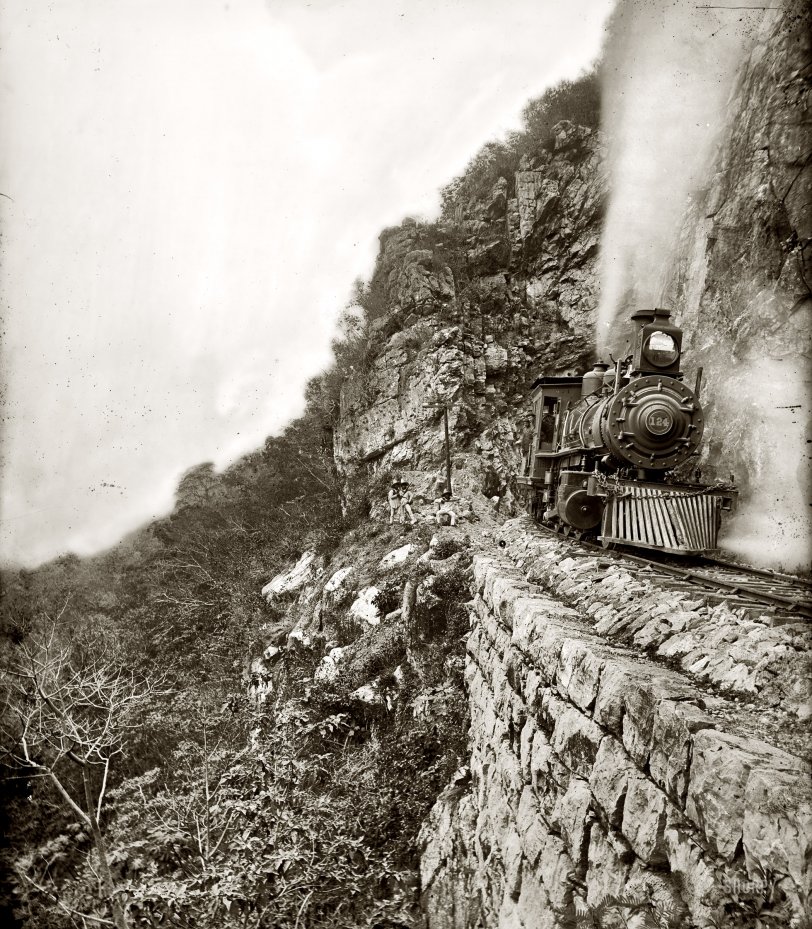


Framed or unframed, desk size to sofa size, printed by us in Arizona and Alabama since 2007. Explore now.
Shorpy is funded by you. Patreon contributors get an ad-free experience.
Learn more.

- Roll your own
- Rugged and real!
- A Charles Purcell - Mama Cass Connection
- Uncle SAAM
- Obfuscation
- One Chocolate Soldier rode away
- Victor Marquis de la Roche
- The Little House Across Way ...
- Vanderbilt Gates
- Vanderbilt Mansion
- You can still see that gate
- Withering heights for me
- So Jim,
- Top Heavy
- Re: Can't Place It.
- Bus ID
- Since you mention it
- The White Pages ?
- Moonlight Tower
- 1907?
- Fire(men) and Water
- Can't Place It
- Can anyone
- Wings
- Where's Claudette and Clark?
- Overbuilt Rolodex
- One song
- Give Me Wings Please!
- PRR
- Pinball Wizards
Printporium
Sidewinder: 1890

San Luis Potosi, Mexico, circa 1890s. "Tamasopo River Canyon." Dry plate glass negative by William Henry Jackson, Detroit Publishing Co. View full size.
Train Chain
The chain on the pilot is actually something you commonly see with the early link and pin type trains. Time and time again, they'd run into cars that didn't have the same types of couplings, and the railroad would have to do something to get them together. So when switching it wasn't uncommon to have to chain cars together, or even in some cases tie them together with lengths of stout rope.
A Day at the Races
Is that Chico Marx leaning out of the cab?
Mexican Central 124
According to Art Wallace's "Mason Steam Locomotives" (2004, p. 167), this is serial No. 752, Mason Locomotive Works' third from last loco produced, and as such this is a rather important picture. 752 was built in 1889 as a standard gauge 2-6-6T Mason Bogie.
If you study the alignment of the locomotive trucks, the cylinders & pilot, and compare it to the boiler, you will note that the boiler is sticking out to the right (the engineer's perspective). Another term might be articulated, and the design is to accommodate sharp curves, such as what you see here. The pic in the book, possibly taken the same day, shows this as a work train.
I am speculating that the corrugated second cab roof is to reduce heat, though in the work train pic the converted box and caboose also have the same type roofs. Perhaps it is also for providing a bit more protection for falling rocks.
Peonage
Not to put too fine a point on it but those would be what used to be called peons, or manual laborers. Not "bandits."
Innovation
Although we probably wouldn't think it, this railroad was relatively innovative for its time. Notice that the locomotive has a Westinghouse air brake pump beneath the footboards near the cab, the rails have some interesting tie clips to keep the gauge from spreading, which would send a train of American miners to their fiery deaths.
Of course, being Mexico, they have to be practical, as the chain wrapped around the pilot shows. I wonder if it was for retrieving cars from sidings with questionable track or removing debris (rocks, trees, cattle, etc.) from the right of way?
"We are the Three Amigos"
Maybe they lost their horses and are trying to hitch a ride on #124. These guys in their light colored clothes were almost impossible to see until you click on full view. Wonder how long that tunnel is that I assume the train is leaving.
Dating
Dave, is this photo dated, or the estimation of the date was based on the style of the locomotive? Judging by the looks of the so-called bandits, I am tempted to say this could actually be a photograph taken at the beginning of the Mexican Revolution, from 1910 - 1912 or so. I mean, the three men are dressed in the same kind of outfit, which could possibly be an uniform of sorts.
[This image is in the 1898 "Catalogue of W.H. Jackson Views," which covered photographs taken from 1880 to 1897. - Dave]
Retouching
The sky here is clearly retouched. Looks almost like a paper negative job. Did they make fresh glass negatives after do such manipulation? Was wondering how one got this sort of tonality on an original glass negative.
[The sky part of the negative was painted with what was probably a wash of black ink. - Dave]
Banditos
When I look at this picture I immediately think "Badges!? We don't need no stinkin badges...vámonos!"
Ay, yi yi yi - I am the Frito Bandito
Sorry señor banditos, we don't have any Fritos onboard.
Precarious Parking
That's a pretty hairy place for a photo op. It looks to me like the combination of that whistle, the vibration of the train when it starts moving and the loose rocks above could be a recipe for a real headache, especially for the banditos beside the track.
Jackson at the railroad
I'm a longtime admirer of William Henry Jackson and a descendant of generations of railroad men. I've often wished someone would publish a collection of Jackson's railroad photos, and now Shorpy is doing it, one photo at a time. Keep 'em coming on up the line!
























On Shorpy:
Today’s Top 5